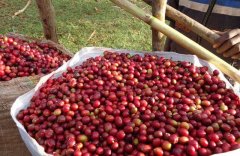Nicaraguan coffee producing area, Nicaraguan coffee bean variety introduction.

Professional coffee knowledge exchange more coffee bean information please follow the coffee workshop (Wechat official account cafe_style)
Nicaragua is mainly divided into four major producing areas, namely, Segovia (Segovias), Madaguelba / Henodeka (Matagalpa/Jinotega), Polgo (Boaco) and Pacific Coast (Pacific). The highest planting height in Segovia area is about 1500-2000, and the coffee produced is the highest SHG (Strictly High Grown). Planted with volcanic ash and shaded by trees, high-quality Nicaraguan coffee is produced. Its flavor is mediocre, soft and slightly sour, so it is suitable for comprehensive coffee.
The volume of Nepalese coffee is the largest of all coffee beans, among which the giant beans produced in Madagelba are the most distinctive. This kind of giant bean particles are larger than ordinary coffee beans, commonly known as elephant beans, with a distinctive special flavor, but also with the round texture of Maragogipe coffee, its sister product Matagalpa contains wild acidity and indescribable aroma.
Coffee trees in this area are several ancient bourbon species, usually planted on high-altitude hillsides, and have been recognized as excellent organic coffee at high altitude by the OCIA (Organic crop improvement Association).
Nepalese coffee is particularly suitable for deep roasting and is recommended for brewing espresso.
With regard to Javanica varieties, as a result of joint research on varieties in several Central American countries in the early 1980s, many varieties were collected to CATIE in Costa Rica.
The purpose of the study includes many aspects, but it is mainly in the research of planting and disease resistance, not aiming at the characteristics of cup feeling. As a result, improved varieties such as Caturra with better planting ability or Catimor with better disease resistance were introduced by some countries, while Java varieties with lower planting ability and weak disease resistance were not introduced.
At that time, Javanica began to be evaluated again in recent years after it was planted in Nicaragua, and it was also recognized as a variety with a high cup feeling.
Javanica has been recorded as a natural mutant of Java varieties, but there is not enough investigation to know.
In addition, the Javanese variety was selected from Ethiopia in Ethiopia in 1928, so it was later called the Javanese variety.
Important Notice :
前街咖啡 FrontStreet Coffee has moved to new addredd:
FrontStreet Coffee Address: 315,Donghua East Road,GuangZhou
Tel:020 38364473
- Prev

How do you make coffee in a coffee pot? How should the coffee powder thickness of the French press pot be?
Professional coffee knowledge exchange More coffee bean information Please pay attention to coffee workshop (Weixin Official Accounts cafe_style) French filter pot referred to as French pot, French pot is the way to extract coffee after soaking coffee powder in hot water for a period of time, so it can extract the sour, bitter and sweet taste of coffee at the same time with the same extraction time. Of course, in addition to sour, bitter and aroma, coffee will also be extracted.
- Next

What does a single farm in Ethiopia mean? The reason for the lack of defective beans and high quality
Professional coffee knowledge exchange more coffee bean information please follow the coffee workshop (Wechat official account cafe_style) African Ethiopian coffee beans, with the development of the coffee industry, in addition to the emerging production areas continue to rise, there are also many special ways to deal with it! "121 batches of slow drying of single-layer solarization in Shengshi Village, Humbera Manor" from Ethiopia.
Related
- Beginners will see the "Coffee pull flower" guide!
- What is the difference between ice blog purified milk and ordinary milk coffee?
- Why is the Philippines the largest producer of crops in Liberia?
- For coffee extraction, should the fine powder be retained?
- How does extracted espresso fill pressed powder? How much strength does it take to press the powder?
- How to make jasmine cold extract coffee? Is the jasmine + latte good?
- Will this little toy really make the coffee taste better? How does Lily Drip affect coffee extraction?
- Will the action of slapping the filter cup also affect coffee extraction?
- What's the difference between powder-to-water ratio and powder-to-liquid ratio?
- What is the Ethiopian local species? What does it have to do with Heirloom native species?

